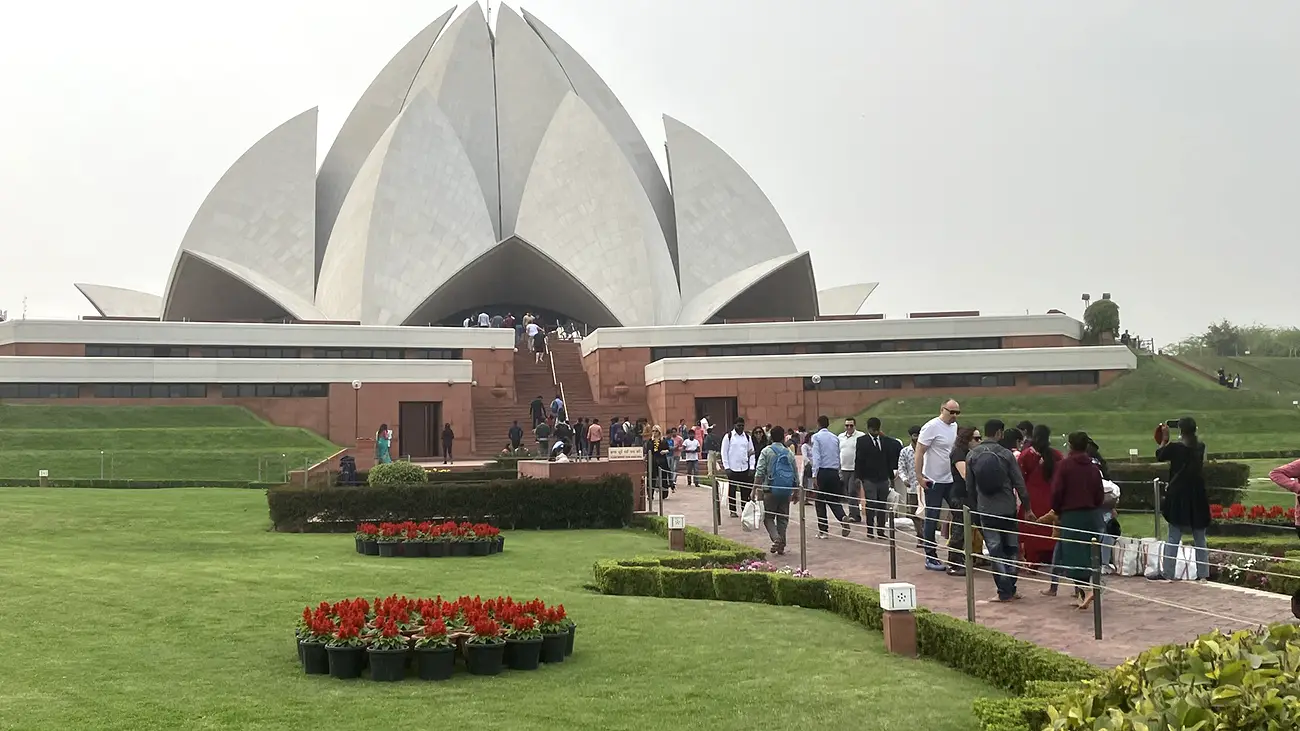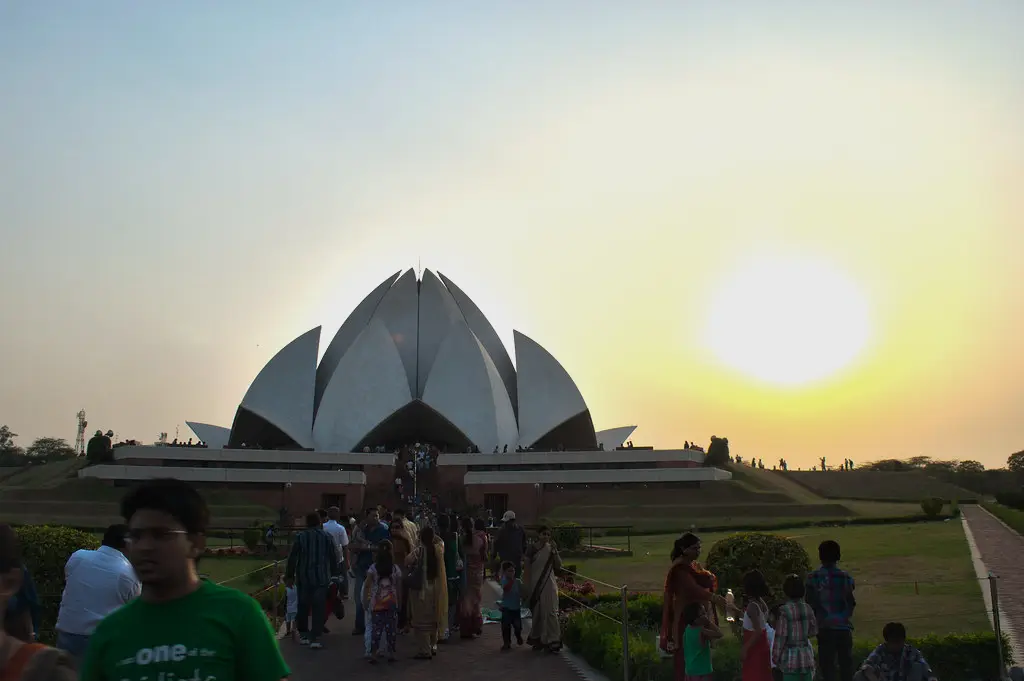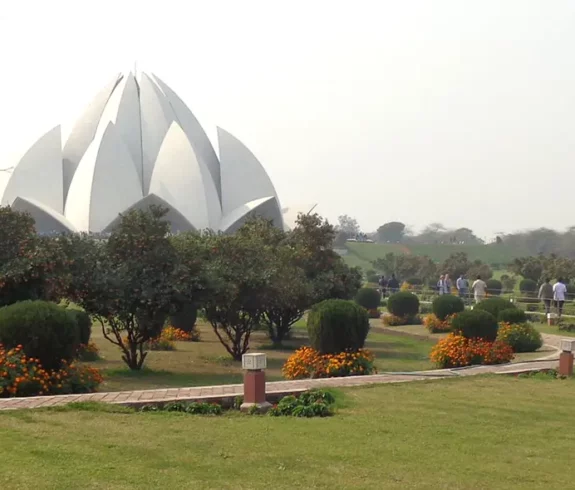The Baha’i Lotus Temple, often called the Lotus Mandir, is a modern landmark and spiritual retreat in New Delhi. Completed in 1986, it became India’s first and only Baha’i House of Worship. Its distinctive lotus-flower design and peaceful surroundings have made it one of the city’s most popular attractions. The temple stands amid green gardens and nine reflecting pools, creating an oasis of calm in the busy town. People from all beliefs and walks of life are invited, creating a welcoming and inclusive environment. Many people admire its architecture, sit in quiet reflection, or enjoy a moment of peace in the gardens.
The Baha’i Faith and Its Philosophy
The Baha’i Faith is a contemporary monotheistic religion established in 19th-century Persia (now Iran). Its followers worship one God and believe all of the world’s major religions come from the same divine source. The Baha’i Faith is built upon the core tenets of divine unity, the essential oneness of all faiths, and the solidarity of humanity.
Baha’i teachings stress that all human beings form one family and that race, nationality, and class barriers must be overcome through understanding and service. The equality of women and men is also an important principle. Baha’is emphasize eliminating all prejudice and championing education and justice for everyone.
They believe science and religion should work together for the benefit of humanity, and they see people from all races and religions as part of one human family destined to live in unity and peace.
The Lotus Temple in Delhi is a Baha’i House of Worship (often called a Baha’i Mandir or Lotus Mandir). In keeping with Baha’i principles, the temple has nine sides and nine doors, and open gardens and ponds surround it.
No fences or barriers; the temple is open from every direction. It welcomes people of every background. It does not display any images, statues, altars, or idols in the spirit of unity. There are no priests or sermons at the temple. Instead, worship at the Lotus Temple consists of readings and prayers from various holy books (including Baha’i scripture and writings from other faiths).
Services are kept respectful and straightforward, with no rituals or fundraising. Anyone may quietly enter the temple to sit, reflect, or pray silently. This openness reflects the Baha’i philosophy that all can find common ground in shared spiritual values.

Architectural Marvel: The Lotus Design
Lotus-Inspired Structure and Symbolism
The iconic design of the Lotus Temple is directly modeled after the lotus flower, representing purity and peace across diverse cultures. The building is formed by 27 large marble “petals” arranged in clusters to create nine sides. Each side has a doorway, reflecting the special importance of the number nine in the Baha’i Faith. Architect Fariborz Sahba, an Iranian-born Canadian, designed the temple to feel both modern and spiritually uplifting.
He chose the lotus motif because it is deeply revered in India and is seen as a universal symbol of purity and rebirth. The petals are arranged in three concentric rings: the inner rings curve inward to form a vault over the central hall, while the outer ring curves outward to create canopies over each of the nine entrances. From a distance, this arrangement makes the temple look like a white lotus flower in full bloom.
Materials and Construction
The temple’s exterior is made of pristine white marble panels from the Penteli mountains of Greece (the same marble used on the Parthenon). These panels cover the reinforced concrete shells of the 27 petals, giving the building its bright white appearance. The floors and interior surfaces are also finished with marble, creating a seamless look throughout the hall. The temple stands on a raised concrete podium, and the walkways and stairs are paved with local red sandstone.
This use of red sandstone for the base and steps ties the modern structure to India’s architectural heritage. Construction of the temple began in 1980, and the foundation stone was laid in 1977. It was completed in late 1986 and dedicated on December 24, 1986. Thousands of Baha’i followers from India and worldwide gathered for the dedication.
The temple opened to the public on January 1, 1987. It was built by the Indian firm Larsen & Toubro, with funds donated by Baha’i communities worldwide. The central hall is about 34 meters high and can accommodate around 2,500 people. As Baha’i scripture requires, no images, statues, or altars are included in the temple’s design.
Light, Water, and Ventilation
Natural light is an essential element of the Lotus Temple’s atmosphere. A hidden glass roof at the top of the central hall and narrow skylights at the base of the petals allow sunlight to filter into the interior. During the day, these openings bathe the hall in soft, diffused light, enhancing the feeling of openness and calm inside the temple.
The design also incorporates a clever passive cooling system. Nine reflecting pools and fountains surround the building like the leaves of a lotus. As a breeze blows over the water, it cools the air naturally. Vents in the floor allow this cooled air to be drawn upward into the hall. Warm air rises and exits through a vent at the top of the dome, creating a natural “chimney effect” that keeps the interior comfortable without air conditioning.
When the sun sets, subtle lighting transforms the temple at night. Spotlights illuminate the white marble petals from below, and their reflections shimmer in the surrounding pools. The glowing temple floats on the water at night, reinforcing the illusion of a lotus flower shining in the darkness.
Visitor Experience and Atmosphere
Visitors to the Lotus Temple often describe the experience as serene and uplifting. The temple has 26 acres of landscaped gardens with flowering shrubs, green lawns, and winding walkways. This peaceful park-like setting is a welcome contrast to the city outside. Many enjoy strolling through the grounds, sitting on benches, or reflecting by the water. The ponds and fountains echo the lotus theme and help create a sense of calm. The entire site feels especially tranquil in the early morning and late afternoon when sunlight is softer.
When you step inside the temple, the atmosphere becomes even more hushed. The main hall is large and circular, with simple wooden benches around the perimeter. The design allows visitors to face inward toward the center. Volunteers or greeters ask guests to please remain quiet. The interior is almost empty of decoration, and natural light filters gently in from above. Many visitors close their eyes in meditation or prayer, while others silently read from their scriptures or the information panels in the hall. There are no formal ceremonies or music; the hall always remains peaceful.
After leaving the prayer hall, guests are invited to visit the Lotus Temple’s visitor information center. This center features displays about the history of the temple, the Baha’i Faith, and the life of its architect, Fariborz Sahba. Exhibits include photographs, models, and text panels. Volunteers are often available to answer questions and provide brochures or maps. The information center helps contextualize what visitors have seen and learned. In 2018, an adjacent education center was added to offer deeper exhibits and community programs on unity and service.
There are a few simple guidelines to follow while visiting. To enter the prayer hall, all guests are requested to take off their footwear; shoe storage bags and racks are provided near the entrance. Noise and active talking are kept to a minimum inside the hall. No cameras or video devices are inside the main prayer area; however, the outer temple structure and gardens are open for photography. The temple is free to enter; everyone may come without prior registration or need to donate. Most guests leave feeling refreshed by the peaceful environment.
Friendly volunteers may hand out simple pamphlets about the temple’s history and the Baha’i Faith for first-time visitors. The information center may also show short films or interactive displays explaining the architecture and its symbolism. Many people plan to spend an hour or two here; some combine the visit with a picnic on the lawn (eating is only allowed in the garden areas). The shaded gardens around the temple are a nice place to sit and reflect after touring the hall. Benches and pergolas provide seating and shade in the gardens.
Overall, a quiet, respectful mood is maintained throughout the site, which helps everyone enjoy the sanctuary. Allow yourself time to absorb the calm atmosphere, and remember to turn off your mobile phone once inside the hall to honor the silence.

Why Visit the Lotus Temple?
Visitors come to the Lotus Temple for many reasons. The unique architecture alone makes it worth the trip. Few buildings in the world look like a giant white lotus flower, and seeing this modern “lotus” up close is an impressive experience. Many travelers appreciate how the temple combines traditional symbolism with innovative design. The shape and materials of the building create a visually striking landmark that photographs beautifully from any angle. As a result, architects, photographers, and casual travelers often include it in their tours. The temple’s open, airy form invites people to come and rest in its presence.
Another reason to visit is the temple’s spiritual openness. It is a place that anyone can enter, regardless of background or belief. In a bustling city like Delhi, the Lotus Temple provides a rare feeling of space and calm. People of different cultures and faiths mingle here peacefully. Many visitors say it is inspiring to sit quietly and reflect on the harmony between people. The setting is thoughtful but simple: there are no idols or altars, and the plain interior invites personal reflection.
The timing of your visit can make it even more special. Early morning and late afternoon are often cited as the best times. At sunrise or sunset, the white petals of the temple can glow with pink and orange hues as the sky changes. The reflecting pools may capture the temple’s image, creating perfect photo opportunities. Soft spotlights illuminate the white petals at night, making the temple look like a glowing lotus on the water. Whether you enjoy photography or appreciate beautiful lighting effects, these moments add to the temple’s appeal.
The Lotus Temple has become iconic in India. It regularly draws about 10,000 visitors daily (nearly 400,000 annually), which is a testament to its popularity. On busy days, lines may form at the entrance, but the experience inside remains calm because of the open design. Many say that visiting here becomes a surprisingly peaceful pause in their day. In short, the combination of stunning architecture, serene gardens, and a universal message of unity makes the Lotus Temple a must-see in Delhi.
Today, the Lotus Temple also boosts the local community. Nearby hotels and tour operators regularly include it in Delhi itineraries. Local vendors sell lotus-themed souvenirs and snacks to the steady stream of pilgrims and tourists. In a small way, the temple has become the area’s economic and spiritual resource. This modern symbol of harmony has left a lasting impression on all who visit.
Practical Information (Key Points)
- Location: Lotus Temple Road, Shambhu Dayal Bagh, Bahapur, New Delhi.
- How to Get There: Take the Delhi Metro Violet Line to Kalkaji Mandir station (about 500 meters away). Taxis and auto-rickshaws are also available, and you will be dropped off at the temple entrance. Several city buses stop near Nehru Place, which is within walking distance.
- Entry Fee: Free (no ticket required).
- Opening Hours: Tuesday to Sunday, 9:00 AM to 5:00 PM (closed on Mondays).
- Best Time to Visit: Early morning or late afternoon (cooler temperatures, smaller crowds, and beautiful light on the temple).
- Facilities: Restrooms, drinking water fountains, shoe storage bags/racks, and wheelchair access. A visitor center with informational exhibits is also available.
In Summary
The Baha’i Lotus Temple is truly a special place. Its stunning architecture and tranquil atmosphere create an environment unlike any other in Delhi. The temple’s message of unity and inclusion is reflected in its design and grounds. Whether you visit to admire the building’s beauty, to meditate in silence, or to escape the city noise, you will find the experience moving. With its convenient access, free entry, and peaceful ambiance, the Lotus Temple offers a memorable and uplifting experience. It is an oasis of calm and harmony for all who visit. Allow yourself an hour to explore fully—sit quietly in the hall and relax in the gardens—to carry away a lasting sense of peace.
